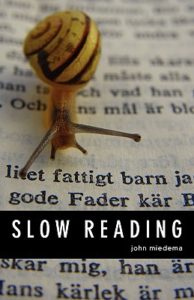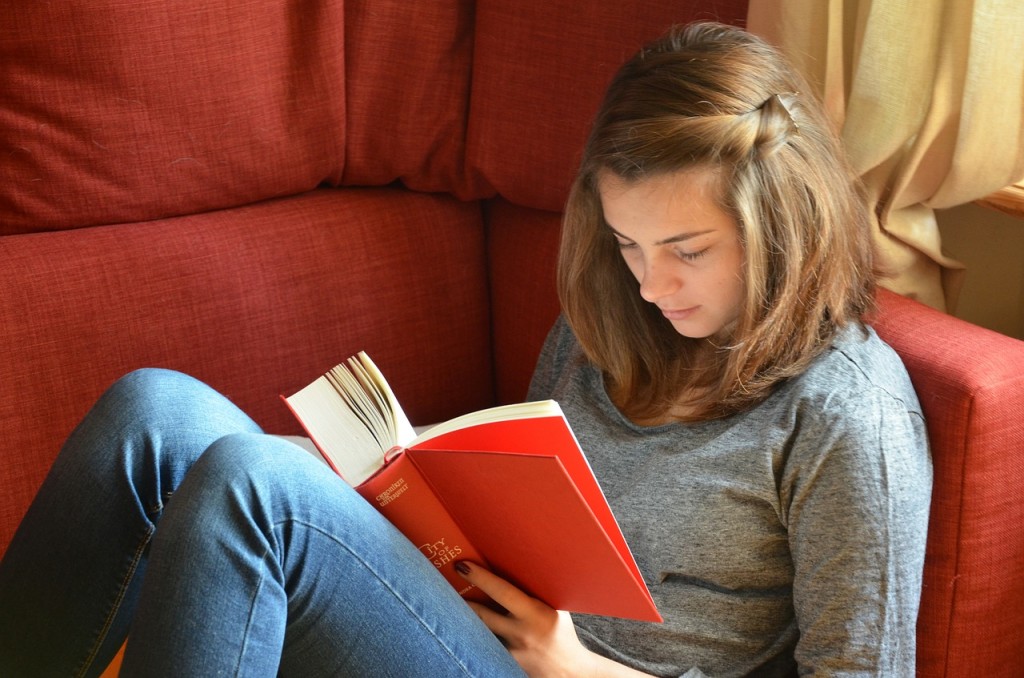Whenever I come across someone’s claim to have read 80, 90, or even 100 or more books in a year, I have to wonder how much they comprehended, appreciated, and now remember of those books. With so much current emphasis on productivity and life hacks, it’s easy to get caught up in the notion that more is better when it comes to reading. I prefer to slow down when I read, to take enough time to appreciate the author’s style and subtlety and craft instead of getting to the last page so I can pick up another book.
Although I believe that I get more out of a novel when I read slowly enough to savor it, I wondered if other people have the same experience. So I did a little research.
Although I’m talking mainly about reading fiction here, there’s also some discussion of reading nonfiction and the differences between reading fiction and reading nonfiction.
 John Miedema put together his book Slow Reading from research for a graduate course in library and information science. He defines slow reading as a voluntary practice done to increase enjoyment and comprehension of a text, a process that some people describe as “getting lost in a book.”
John Miedema put together his book Slow Reading from research for a graduate course in library and information science. He defines slow reading as a voluntary practice done to increase enjoyment and comprehension of a text, a process that some people describe as “getting lost in a book.”
This book is about reading fiction. Here are a few quotations:
- “A fictional work provides a sand box for imagining other identities and choices”(p. 56).
- “Children can use fiction as a testing ground for their future selves. Is there any reason to stop this process when we reach adulthood? It is sad and a bit creepy to watch those adults who cease to imagine. It is as if their inner landscape is withering” (p. 57).
- ”Slow readers have a particular capacity to open up to new ideas, and allow the sense of self to be transformed” (p. 62).
In 3 Key Advantages of “Slow Reading” That Turbocharge Your Learning Gregg Williams, a marriage and family therapist, acknowledges that productivity drives a lot of what we do—we want to get more done, and we therefore have to work faster to become more productive. This drive is most apparent in our desire to consume as much information as possible. We read quickly so we can move on to the next book or article. According to Williams, fast reading may work in some circumstances, but real comprehension demands slow reading.
Williams describes his own experience with realizing how fast reading in fact slowed him down. It takes him a while to get around to the meat of his argument, but he ends up pointing out three advantages of taking time to read a text slowly:
- Slow-reading uncovers “hidden” gems.
- Stories lead to deeper truths.
- Slow-reading adds to your web of knowledge.
He explains that “slow reading is also a very good idea whenever you are reading to understand any body of knowledge (for example, textbooks and popular nonfiction).” When you’re trying to learn something, slow reading saves you time in the long run because you can follow the logical flow of facts and associations.
In many cases fast reading may serve your purpose better than slow reading, Williams concludes. “The good news is that you can decide to switch between the two.”
Slow reading is related to what some others call active reading. Actively reading fiction requires slowing the reading process way down. In The medium is not the message Leah Price, who teaches English at Harvard, looks at the slow reading movement. Most proponents of this movement, she notes, are literary critics, who “care as much about form as about content.” She notes:
Ever since modern literatures were first taught at university a couple of centuries ago, their average professor has read at the same pace as her seven-year-old.
Reading slowly allows us to savor the words, to see and appreciate how the author has used techniques such as imagery and sentence structure to construct a story that resonates on several levels. When we read literature simply for its narrative sequence—first this happened, then that happened, and then the next thing happened—we miss all the artistic effort that the best writers put into crafting their tales. (For ideas on how to do such close reading, see How to Read Literature Like a Professor by Thomas C. Foster, Harper/Collins, 2003).
Tim Parks, novelist and Associate Professor of Literature and Translation at IULM University in Milan, laments how much his students seem to miss when reading literature in A Weapon for Readers. He writes that we approach literature with too much reverence and therefore treat it uncritically:
If a piece of writing manifests the stigmata of literature—symbols, metaphors, unreliable narrators, multiple points of view, structural ambiguities—we afford it unlimited credit. With occasional exceptions, the only “criticism” brought to such writing is the kind that seeks to elaborate its brilliance, its cleverness, its creativity.
This reverence toward the written word, he says, came of age in the second half of the twentieth century and “is reflected in the treatment of the book itself. The spine must not be bent back and broken, the pages must not be marked with dog ears, there must be no underlining, no writing in the margins.”
Parks particularly noticed this attitude toward the sanctity of the written word when working with students studying translation:
I would give them the same text in English and Italian and ask them to tell me which was the original text. Or I would give them a text without saying whether it was a translation or not and ask them to comment on it. Again and again, the authority conveyed by the printed word and an aura of literariness, or the excitement of dramatic action, or the persuasive drift of an argument, would prevent them from noticing the most obvious absurdities.
Be sure to look at his examples of such absurdities, which make his point readily evident.
In wondering how to help his students become better readers,
I began to think about the way I read myself, about the activity of reading, what you put into it rather than what was simply on the page. Try this experiment, I eventually told them: from now on always read with a pen in your hands, not beside you on the table, but actually in your hand, ready, armed. And always make three or four comments on every page, at least one critical, even aggressive.
The result? “[I]t was remarkable how many students improved their performance with this simple stratagem”:
There is something predatory, cruel even, about a pen suspended over a text. Like a hawk over a field, it is on the lookout for something vulnerable. Then it is a pleasure to swoop and skewer the victim with the nib’s sharp point. The mere fact of holding the hand poised for action changes our attitude to the text. We are no longer passive consumers of a monologue but active participants in a dialogue. Students would report that their reading slowed down when they had a pen in their hand, but at the same time the text became more dense, more interesting, if only because a certain pleasure could now be taken in their own response to the writing when they didn’t feel it was up to scratch, or worthy only of being scratched.
This transformation from “passive consumers of a monologue” into “active participants in a dialogue” describes the interaction between a reader and a literary text that is the basis of reader-response criticism. In The Reader, the Text, the Poem: The Transactional Theory of the Literary Work (1978), Louise M. Rosenblatt calls this interaction “the reader’s contribution in the two-way, ‘transactional’ relationship with the text” (p. ix). In Rosenblatt’s terminology, the text is the written work and the poem is the meaning that the reader creates in interaction with the written words.
Arming ourselves with a pen and approaching a work of literature as our partner in an active exchange will allow us to focus on reading fiction as both an artistic and a pleasurable experience—also as a necessary experience, according to Parks:
For the mindless, passive acceptance of other people’s representations of the world can only enchain us and hamper our personal growth, hamper the possibility of positive action. Sometimes it seems the whole of society languishes in the stupor of the fictions it has swallowed.
I read a lot of articles and web sites about reading, and I’ve lost track of how many times I’ve seen the quotation—usually encased in a text box with a fancy frame—“No two readers ever read the same book.” This is a succinct statement of the hypothesis of reader-response criticism: Readers create their individual sense of meaning because they bring to the reading process their unique consciousness and set of personal experiences. I find that in order to produce this transactional process between the book and me, I have to slow down and take time to savor the reading process. And that’s why I read 40 books a year, not 100.
© 2017 by Mary Daniels Brown

